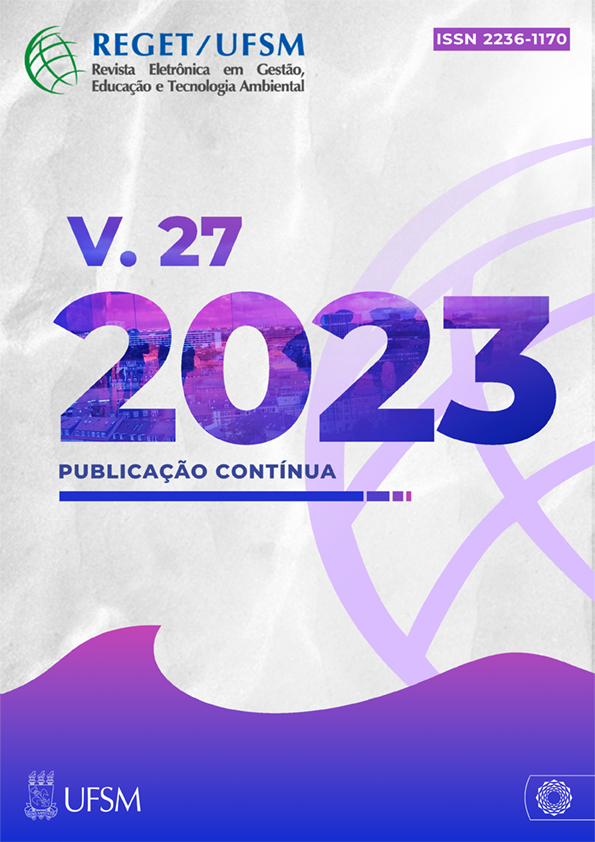Assessment of the economic sustainability of water capture from surface and underground water sources to supply urban areas
DOI:
https://doi.org/10.5902/2236117069537Keywords:
Water supply, Conception, Type of water source, Indicators, Economic sustainability, PerformanceAbstract
Analyze the implications of the configuration of the Sectors that make up the Water Supply Systems (WSSs) in the municipality of Belém, capital of the state of Pará, on their economic sustainability. The research was developed in three stages. The first stage consisted of identifying and collecting information regarding the WSSs operated by Companhia de Saneamento do Pará – COSANPA. In the second stage, operational and commercial indicators were determined for both Sectors selected as the most suitable for comparison, in this case the 12th Sector and the 23rd Sector. In the last stage, an analysis of the economic sustainability of selected Sectors was performed. It was verified that 04 of the 39 WSSs collect raw water from a surface water source, while the other 35 WSSs use deep wells (about 270 meters deep) to collect water from Pirabas artesian aquifer. In addition, operational efficiency indicators were calculated, such as the “Distribution Losses Index” – 69,08% (12th Sector) and 72,67% (23rd Sector), and economic sustainability indicators, such as the “Total Expense with the Services per Billed Cubic Meter” – R$1,92/m³ (12th Sector) and R$1,29/m³ (23rd Sector). In conclusion, due to the classification of both studied Sectors, regarding operational efficiency and economic sustainability, as inefficient and partially sustainable respectively, it is recommended to improve the operational and comercial management of the regional concessionaire, in compliance with the premises of Law No. 14.026/2020 and to ensure the economic and financial balance of the service provider.
Downloads
References
AGÊNCIA NACIONAL DE ÁGUAS (2013). Atlas Geográfico Digital de Recursos Hídricos do Brasil. Disponível em: http://portal1.snirh.gov.br/atlasrh2013/. Acesso em: 13 mai. 2020.
AGÊNCIA NACIONAL DE ÁGUAS (2018). Estudos Hidrogeológicos para a Gestão das Águas Subterrâneas da Região de Belém/PA. Disponível em: https://metadados.snirh.gov.br/geonetwork/srv/api/records/4e560d0e-9534-44e2-8e19-31ba5fb3596a. Acesso em: 16 jul. 2021.
BARROS, A. J. A.; MESQUITA, K. F. C.; BEZERRA, G. C. M.; CONDURU, M. T.; PEREIRA, J. A. R. Impacto da Expansão da Rede de Distribuição de Água na Despesa de Energia Elétrica nos Municípios do Arquipélago do Marajó, estado do Pará, Brasil. In: SEMINARIO IBEROAMERICANO DE REDES DE AGUA POTABLE Y DRENAJE URBANO, 15., 2017, Bogotá – Colômbia. Anais[...]. Bogotá – Colômbia: Universidad de Los Andes, 2017.
BEZERRA, G. C. M. Avaliação da Sustentabilidade da Prestação dos Serviços de Abastecimento de Água em Municípios. 2012. Dissertação (Mestrado em Engenharia Civil) – Programa de Pós-Graduação em Engenharia Civil – Universidade Federal do Pará, Belém/PA, 2012.
BRASIL (2020). Lei n.º 14.026, de 15 de julho de 2020. Disponível em: http://www.planalto.gov.br/ccivil_03/_ato2019-2022/2020/lei/L14026.htm. Acesso em: 01 ago. 2020.
BRASIL (2021). Decreto n.º 10.710, de 31 de maio de 2021. Disponível em: https://www.in.gov.br/en/web/dou/-/decreto-n-10.710-de-31-de-maio-de-2021-323171056. Acesso em: 03 jun. 2021.
COMPANHIA DE SANEAMENTO DO PARÁ – COSANPA. Relatório de Informações Operacionais e Comerciais. Belém/PA, 2021a.
COMPANHIA DE SANEAMENTO DO PARÁ – COSANPA. Sistema Integrado de Gestão de Serviços de Saneamento – GSAN. Belém/PA, 2021b.
FERREIRA, J. F. H. Avaliação do Consumo e da Despesa de Energia Elétrica no Estudo de Concepção de Sistema de Abastecimento de Água. 2019. Dissertação (Mestrado em Engenharia Civil) – Programa de Pós-Graduação em Engenharia Civil – Universidade Federal do Pará, Belém/PA, 2019.
FREITAS, N. C. Proposta de um Sistema de Apuração de Custos para Empresas de Saneamento: Um Estudo de Caso na Companhia de Água e Esgoto do Ceará –
CAGECE. 2008. Dissertação (Mestrado Profissional em Controladoria) – Programa de Pós-Graduação em Controladoria – Universidade Federal do Ceará, Fortaleza/CE, 2008.
INSTITUTO BRASILEIRO DE GEOGRAFIA E ESTATÍSTICA (2019). IBGE Cidades. Disponível em: https://cidades.ibge.gov.br/. Acesso em: 28 mai 2020.
INSTITUTO BRASILEIRO DE GEOGRAFIA E ESTATÍSTICA (2020). Projeções Populacionais. Disponível em: https://www.ibge.gov.br/estatisticas/sociais/populacao/9103-estimativas-de-populacao.html?=&t=o-que-e. Acesso em: 28 mai 2020.
LIMA, T. C. S.; MIOTO, R. C. T. Procedimentos Metodológicos na Construção do Conhecimento Científico: a Pesquisa Bibliográfica. Rev. Katál, Florianópolis/SC, v. 10, n. esp., p. 37-45, 2007. DOI: https://doi.org/10.1590/S1414-49802007000300004
PEREIRA, J. A. R.; CONDURÚ, M. T. Abastecimento de Água: Informação para Eficiência Hidroenergética. 1ª ed. João Pessoa: Editora Universitária da UFPB, 2014. 127 p.
SILVEIRA, D. T.; GERHARDT, T. E. Método de Pesquisa. 1ª ed. Porto Alegre/PR: Editora da UFRGS, 2009.
SISTEMA NACIONAL DE INFORMAÇÕES SOBRE SANEAMENTO (2020a). Série Histórica. Disponível em: http://app4.mdr.gov.br/serieHistorica/. Acesso em: 07 jul. 2020.
SISTEMA NACIONAL DE INFORMAÇÕES SOBRE SANEAMENTO (2020b). Glossário de Informações e Indicadores. Disponível em: http://www.snis.gov.br/diagnosticos. Acesso em: 29 jul. 2020.
UNIVERSIDADE FEDERAL DO PARÁ. Grupo de Pesquisa Hidráulica e Saneamento. Diagnóstico dos Sistemas de Abastecimento de Água e de Esgotamento Sanitário dos Municípios de Belém, Ananindeua e Marituba. Belém: UFPA/NUMA, 2013. 1 v., 295 p.
UNIVERSIDADE FEDERAL DO PARÁ. Grupo de Pesquisa Hidráulica e Saneamento. Plano Diretor do Sistema de Abastecimento de Água da Região Metropolitana de Belém. Belém: UFPA/NUMA, 2006. 2 v., 285 p.
Downloads
Published
How to Cite
Issue
Section
License

This work is licensed under a Creative Commons Attribution-NonCommercial-ShareAlike 4.0 International License.
DECLARATION




